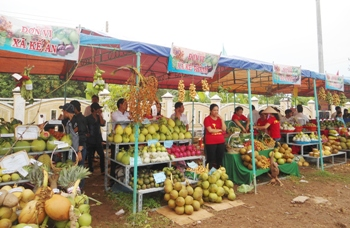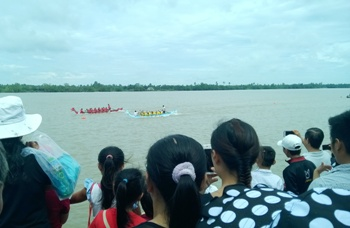The islet - My Phuoc hamlet was formed and developed by the deposition and accretion of Hau river' alluvium, with a natural area of more than 1,020ha, about 3.5km in length, the widest part of 0.6km in the middle. It's narrow towards the head and tail, so the islet is shaped like a dinghy.
According to the elders on the islet, My Phuoc islet was formed about 150 years ago. At first, It was just mudflats with the life of cork trees and mixed, vigorous plants and some wild animal species. Over time of alluvial accumulation of the Hau river, the dune was formed and identified with the name Cong Dien dune in the early twentieth century, under French colonial rule. At that time, people didn't have freedom to come to the dunes to explore and live. Until 1946, only a few people came to the dunes to explore and grow crops for living. Around the end of the 50th decade, alluvium continued to accumulate to create a new range of dunes, located close to Cong Dien dune, separated by a small canal and called mud dune. The land here was fertile, the crops and plants grew well, so more and more people came here to live. They began to grow fruit trees such as bananas, sapoche, oranges, and then special fruit trees such as rambutan, mangosteen, durian... which created a new look for this land. After the event that the puppet president Nguyen Van Thieu landed on Cong Dien islet, it was called national isle. However, the name change was only a formalization, the islet is still under the control and supervision of the puppet government. Living in the enemy's erea, but people on the dunes still headed towards the revolution. People house revolutionary cadres in the region. The youth of the dunes set out to join the resistance war. After the South was completely liberated, the country was unified, national islet was established in My Phuoc hamlet, commonly known as My Phuoc dune (including national and mud dunes) until now.

Fruit stalls at the Garden-River Festival on My Phuoc islet
Living in a peaceful scene, blessed by nature with fresh water all year round, lush land, besides raising poultry, shrimp and fish, people on the islet strongly grow specialty fruit trees to develop family economy and enrich the natural ecological landscape of the islet. Since then, people's lives have been stable, full and prosperous. Fruit farming continues to develop that is known by people inside and outside the area who visit the islet land in the middle of the Hau River with sweet fruit trees, charming river scenes, sincere people...
My Phuoc Islet becomes busy and bustling, attracting a large number of locals and tourists from near and far to gather here on the occasion of Doan Ngo New Year (May 5th of the lunar calendar) with the main highlight of the Garden River Festival. This is a typical festival of Ke Sach district and is maintained by the province every year. The festival aims to honor the fruits of Ke Sach and Southern gardens, so that gardeners can share and get experiences in growing and developing fruit trees in accordance with the needs of the market and tourists, better serve the needs of visitors.

Culinary contest on the occasion of the Hick River Festival on My Phuoc islet
At the opening of the festival, from the early morning, ferries have in turn brought tourists across the river to My Phuoc islet to have fun and enjoy the fruits and fresh air of the rustic isle. In recent years, in order to facilitate tourists from far away to come and participate, the festival has been held for 2 days (May 4th-5th of the lunar calendar) instead of just one day (May 5th lunar calendar). Currently, the Garden River Festival is held with a fairly large scale with outstanding activities such as delicious fruit contest and fruit exhibition. Visitors can use it on site or buy it as a gift. Visitors will be interesting to enjoy crispy, golden pancakes (Xeo cakes) served with vegetables available in the dunes; The Food Festival Competition will help visitors discover the typical culinary culture of the river region; arts programs for tourists, the festival of Don Ca Tai Tu, the exhibition of socio-cultural - economic achievements of the district and province and folk games for visitors such as leap bridge acrossing, bag jumping, pot breaking... or dragon boat racing of teams from units in the province, creating interest for tourists with the cultural beauty of the river region.

Dragon boat racing on the occasion of the Garden River festival on My Phuoc islet
In order to better serve and meet the entertainment and relaxation needs of tourists when coming to My Phuoc islet, Ke Sach district has invested in building and completing the infrastructure here such as the central square, lighting system, cool house, yard fence, flower tubs. Besides, the main roads with the length of 300m in the middle of the dunes, leading from the garden tourism entrance gate to My Phuoc islet to the pier crossing the dunes, have also been concreted and widened from 2m to 4m to ensure safe transport and circulation for people and tourists when visiting the islet. Now, when coming to My Phuoc islet on the day of the Dragon Boat Festival, visitors will be able to visit a round the dunes, watch and enjoy the fruits with a shuttle service by electric car, serviced by Satraco International Joint Stock Company. Some households in the dunes have built a community-based tourism model, visitors will learn and participate in some daily activities and the lives of the people of the dunes, especially cooking and enjoying rustic dishes such as fresh catfish cooked in sour soup with mangrove fruits and boiled snakehead fish... will make diners forever remember the fresh countryside on Hau river.
With the advantage of geographical location, beautiful landscape bestowed by nature with typical features of the river region, My Phuoc islet was recognized by Soc Trang Province People's Committee as a provincial-level scenic relic according to Decision No. 141/QDHC-CTUBND issued on February 1st, 2008. On the basis of the general plan to develop routes and tourist attractive places associated with the conservation of nature, river culture, protection of natural landscapes and the environment..., The District People's Committee has encouraged businesses and local people to invest in exploiting and developing forms of eco-tourism, cultural tourism, exploring nature, and planning four-season fruit areas to serve tourists, gradually forming quality products such as river and garden tourism, combining cultural, artistic and resort activities... to create an attractive destination for tourists, contributing to the economic and social development of the district./.